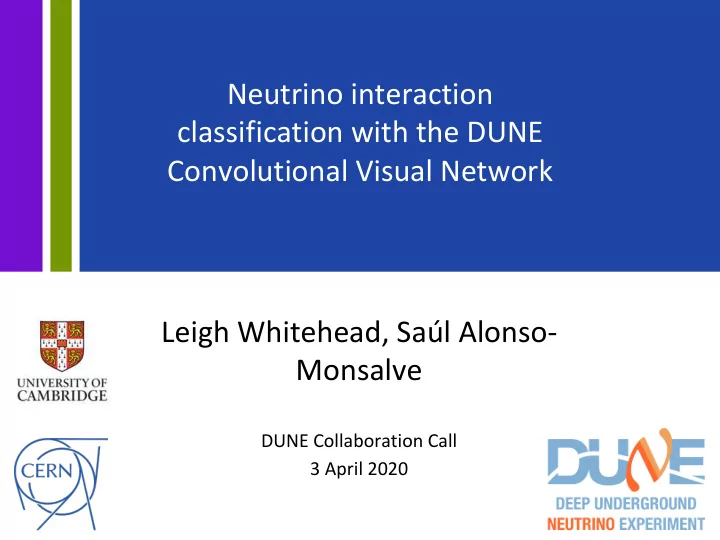

Neutrino interaction classification with the DUNE Convolutional Visual Network Leigh Whitehead, Saúl Alonso- Monsalve DUNE Collaboration Call 3 April 2020
Purpose of the paper • Paper of the CVN Particle ID used in the TDR sensitivities. • Title: “Neutrino interaction classification with the DUNE Convolutional Visual Network.” • Primary authors: Leigh Whitehead, Saúl Alonso Monsalve. • ARC: Alex Himmel, Andy Blake, Dan Cherdack, Andrea Scarpelli, Taritree Wongjirad. • DUNE-doc-14125. • Target journal: Physical Review D (PRD). • Deadline of the review: Monday, April 13 th . Leigh Whitehead, Saúl Alonso-Monsalve 2
Overview 1. Introduction to DUNE. • • CP -violation measurement. • DUNE FD simulation and reconstruction. 2. CVN neutrino interaction classifier. • CVN inputs, outputs, and network architecture. • Training details. • 3. Neutrino flavor identification performance. • Focus on CC ν e and CC ν μ selections. • Efficiencies of 90% for CC ν e and 95% for CC ν μ. • 4. Exclusive final state results. • • Results using the CVN outputs that count the number of final-state particles for: protons, charged pions, and neutral pions. 5. Robustness. • • Evaluate the CVN performance as a function of different observable physics parameters. 6. Conclusion. • Leigh Whitehead, Saúl Alonso-Monsalve 3
Introduction to DUNE Gives an introduction to neutrino physics, the experiment and the TDR • CP-violation analysis. We include two plots of the event selection from the TDR. • These are the CC v e • and CC v e events for a range of d CP values. Leigh Whitehead, Saúl Alonso-Monsalve 4
CVN neutrino interaction classifier This section describes the details of the CVN. • The architecture including all of the inputs and outputs. • Details of the training sample and methods. • Example input images of signal and background events. • Leigh Whitehead, Saúl Alonso-Monsalve 5
CVN neutrino interaction classifier We include a schematic diagram of the • network architecture. Provide full details of the training • procedure and the samples used. Plots of the loss and accuracy • during the training process. Leigh Whitehead, Saúl Alonso-Monsalve 6
Neutrino flavor identification performance This section describes the main result of the paper. • Corresponds directly to the results shown in the TDR. • We show the distribution of the CVN classifier score for the v e and v u • hypotheses for FHC and RHC beams. Leigh Whitehead, Saúl Alonso-Monsalve 7
Neutrino flavor identification performance This section describes the main result of the paper. • Corresponds directly to the results shown in the TDR. • We show the distribution of the CVN classifier score for the v e and v u • hypotheses for FHC and RHC beams. Leigh Whitehead, Saúl Alonso-Monsalve 8
Neutrino flavor identification performance The “final result” shown in this paper is the selection efficiency using • the CVN compared to the CDR analysis. Leigh Whitehead, Saúl Alonso-Monsalve 9
Neutrino flavor identification performance The “final result” shown in this paper is the selection efficiency using • the CVN compared to the CDR analysis. Leigh Whitehead, Saúl Alonso-Monsalve 10
Exclusive final state results This section describes the potential of the other CVN outputs that • count the number of final state particles. This goes beyond what was used in the TDR analysis. • Provides a clear proof-of-principle for sub-dividing the FD event • selection in the future. Leigh Whitehead, Saúl Alonso-Monsalve 11
Robustness This section is aimed at convincing the reader that we understand what • the CVN is doing and that it behaves in an expected way as a function of different physics parameters. For example, we see that the selection efficiency drops as a we • increase the hadronic energy in the system. Leigh Whitehead, Saúl Alonso-Monsalve 12
Robustness This section is aimed at convincing the reader that we understand what • the CVN is doing and that it behaves in an expected way as a function of different physics parameters. Similarly, we see NC background events with higher acceptance as the • pion energy increases. Leigh Whitehead, Saúl Alonso-Monsalve 13
Conclusion Reiterate the impressive performance of the CVN and that it is a robust • classification algorithm. Suggest, dependent on further studies, that the particle counting • outputs have the potential to increase the sensitivity further. Leigh Whitehead, Saúl Alonso-Monsalve 14
Public data release • Gitlab project: • https://gitlab.cern.ch/salonsom/cvn-paper. • The code runs the CVN over a small sample. • The sample consists of 20 random MC events. • There is a README file available with a detailed description of the code. • The testing script produces a file called results.txt . This can be compared to ./output/expected_results.txt to ensure the code has executed correctly. Leigh Whitehead, Saúl Alonso-Monsalve 15
Mechanics of the review We’re currently about half-way through the review period. • Comments are due back on Monday, April 13 th . • Send to ahimmel@fnal.gov, leigh.howard.whitehead@cern.ch, • saul.alonso.monsalve@cern.ch. In doc-14125 you can find a draft of the paper as well as a spreadsheet • template for comments. Please fill in comments in the appropriate tab depending on what • the comments is on along with the column marking line, fig #, etc. Put an X in the “Minor?” column if you don’t feel you need a • response to your comment from the authors. Leigh Whitehead, Saúl Alonso-Monsalve 16
Neutrino interaction classification with the DUNE Convolutional Visual Network Leigh Whitehead, Saúl Alonso- Monsalve DUNE Collaboration Call 3 April 2020
Recommend
More recommend